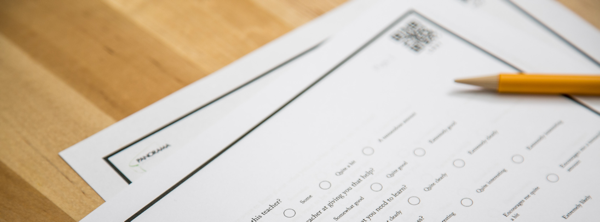Students just gave you concrete feedback through your latest survey. Do you have a plan for translating those responses into real improvements this semester?
Districts frequently collect student feedback from schools. Turning that data into coordinated action requires clear processes, assigned responsibilities, and ways to track whether changes are working. A framework for actioning feedback helps you move from survey results to implementation plans with specific owners, deadlines, and success metrics.
This guide walks you through analyzing survey data, assigning clear ownership for each action, and tracking progress to ensure student voices drive real changes in your schools.
What is a Student Survey Action Plan?
A student survey action plan is a framework that turns student feedback into concrete actions with clear ownership and timelines.
Student survey action plans define what changes to make based on survey results. The plan identifies which findings require action, assigns responsibility to district or school leaders, establishes timelines, and defines how you'll measure its impact. Without a formal plan, survey results often sit in reports while competing priorities pull attention elsewhere.
Why Student Survey Action Plans Matter for Your District
Action plans create accountability for turning student voice into changes students can see and experience. With action plans, students see direct connections between their feedback and school changes. When districts act on survey findings, students learn their voices matter and continue engaging in future feedback opportunities. These are also possible with action plans:
- Districts avoid scattered initiatives that compete for time and resources. Action plans coordinate efforts across schools so everyone works toward aligned goals rather than launching disconnected programs.
- Schools work toward common goals while addressing their unique needs. District-level action plans provide direction while allowing schools to tailor implementation to their specific contexts and student populations.
- Teachers get clear direction on priorities instead of conflicting messages. When district leaders communicate which improvements matter most, teachers can focus their limited time on changes that align with student-identified needs.
- Resources go to areas that students identified as most important. Budget decisions, professional development, and staff time can be allocated based on what students said they need rather than assumptions about their experiences.
- Progress becomes measurable rather than anecdotal. Action plans define success metrics upfront, allowing districts to track whether changes are making a difference and adjust strategies based on evidence.
How To Turn Survey Findings Into Action Plans
District leaders can transform survey data into system-wide improvements by analyzing survey data, identifying root causes, and implementing school-wide strategies.
1. Identify Key Survey FindingsIsolate survey findings that reveal system-level opportunities for improvement. Look beyond individual responses to patterns that indicate structural issues (or successes) across your district.
Examine results across schools, grade bands, and demographic groups to understand if any disparities exist in the system. Focus on areas where data suggests your systems, policies, or practices may not be serving all students. Flag topics that surface consistently across multiple schools or that show significant variation between buildings.
2. Conduct Root Cause AnalysisDistrict-level challenges rarely have simple causes. Investigate the systems, structures, policies, and practices that contribute to the patterns you identified in your survey data.
Engage stakeholders, including students, families, teachers, and leaders at multiple levels, to understand their perspectives on relevant issues. Look for connections between survey findings and other district data sources, such as academic performance, attendance, and discipline. Consider whether current initiatives, resource allocation, or professional development gaps may be contributing factors. Examine whether policies or procedures create unintended barriers for certain student groups.
3. Develop System-Level StrategiesDesign strategies that address root causes through changes to district systems, policies, professional development, or resource allocation. These should be Tier 1 approaches that strengthen universal supports for all students.
Determine whether your strategy requires shifts in instructional practices, school climate initiatives, family engagement approaches, staff training, or student support structures. Align strategies to existing district priorities and frameworks like MTSS or PBIS rather than creating parallel initiatives. Ensure you have the capacity, resources, and leadership support needed to implement with fidelity across schools, and consider which strategies can be scaled district-wide versus piloted in select schools first.
4. Create Your Implementation PlanBuild an implementation plan that clarifies ownership, timelines, resource requirements, and success metrics. Strong plans anticipate implementation challenges and include mechanisms for monitoring progress.
Assign executive sponsors and implementation leads with authority to drive change, and establish clear success metrics tied to your strategic goals. Define rollout phases and milestones that account for the complexity of district-wide change. Allocate budget, staff time, and professional development resources needed for success. Build communication plans that keep school leaders, staff, families, and students informed. Create feedback loops that allow you to course-correct as implementation unfolds.
5. Monitor Progress and AdjustDistrict leaders must balance staying the course with responding to implementation data. Build regular review cycles into your plan to assess progress and make informed adjustments.
Establish quarterly data reviews with district leadership to examine implementation metrics and early outcome indicators. Use surveys and focus groups to gather rapid feedback from schools on what's working and what barriers they're encountering. Compare year-over-year survey results to measure whether your strategies are producing the intended shifts. Share progress transparently with your board, staff, and community. Make strategic adjustments when data suggests your approach isn't producing results, but avoid abandoning initiatives before they've had time to take root.
Make Student Voice Part of How Your District Works
To create lasting change, student voice needs to become embedded in regular district operations.
- Build Action Planning Into Your Calendar
Add standing agenda items for progress reviews at monthly cabinet meetings. Treat these as non-negotiable. - Build Sustainable Systems
Write process guides with screenshots and examples. Train multiple people for each key role. Store all materials in shared drives with clear naming conventions. - Keep Students at the Center
Maintain a student advisory council meeting monthly with the superintendent. Include student voting members on district improvement committees. - Monitor Relevant Data Throughout the Year
Track metrics that connect to your improvement goals. If you're working on school climate, review discipline data and attendance patterns. If you're addressing student engagement, monitor participation in school activities and classroom behaviors. Look at data monthly or quarterly to spot trends early. Pay attention to whether certain schools, grade levels, or student groups show different patterns than others. - Gather Feedback Each Quarter
Don't wait until the end of the year to hear from students and staff. Conduct student surveys to check whether they're noticing changes. Run student panels or focus groups to understand their experiences in more depth. Ask teachers and staff to submit short implementation notes describing what's working and what challenges they're encountering. This ongoing feedback helps you adjust your approach before problems become entrenched. - Compare Survey Results
When you administer your next full survey, compare the results to previous years. Create charts showing year-over-year changes by question and topic area. Break down results by school, grade level, and demographic group to see where progress happened and where it didn't. Celebrate improvements publicly with your school community to demonstrate that their feedback led to real change. For areas that didn't improve despite your efforts, analyze the reasons. Use these insights to refine your approach for the next cycle.
How Panorama Helps You Turn Feedback Into Action
When schools take student voice seriously, action planning becomes more than a compliance exercise. It becomes a catalyst for meaningful change. By listening closely to what students say about their experiences, relationships, and sense of belonging, educators can uncover patterns that surface the real barriers to engagement.
If you're ready to make student feedback truly actionable, Panorama’s Student Survey gives you the clarity and confidence to do it well. With research-backed questions, easy-to-read reports, and tools that help teams translate insights into action, Panorama supports schools at every stage of the student voice journey.




.webp?width=478&height=557&name=panorama_student_survey-1%20(1).webp)


